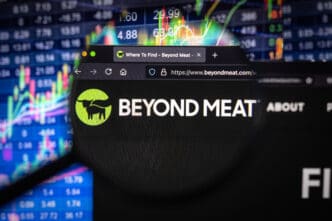Executive Summary
The Story So Far
Why This Matters
Who Thinks What?
Plant-based meat company Beyond Meat Inc. (BYND) experienced a dramatic 1,600% stock surge over four days in mid-October, climbing from $0.52 per share on October 16 to a pre-market high of $8.85 by October 22. This rapid ascent, accompanied by daily trading volumes exceeding 2 billion shares, initially sparked speculation of a short squeeze among meme stock investors. However, an analysis by Sean Williams points to widespread social media misinformation and the fear of missing out (FOMO) as the primary drivers, rather than a genuine short squeeze.
Misinformation Drives Rally
The significant rally in Beyond Meat’s shares was largely fueled by inaccurate claims circulating on social media platforms and some online publications. These sources suggested that the company’s short interest, relative to its float, was as high as 80% to over 100%, leading to expectations of a massive short squeeze.
Such figures, if accurate, would typically indicate conditions ripe for a short squeeze, where a rapid increase in stock price forces short-sellers to buy back shares to cover their positions, further driving up the price. However, a deeper examination of company filings revealed these figures to be substantially incorrect.
Share Count and Actual Short Interest
On October 13, Beyond Meat announced that approximately $1.115 billion of its convertible notes due in 2027 had been tendered. This conversion resulted in the issuance of 316,150,176 new shares on October 15.
Consequently, the company’s outstanding share count dramatically increased from approximately 76 million shares to 397,607,401 shares as of October 15. This more than quintupled the total number of shares available in the market.
With this updated share count, the actual short interest in Beyond Meat stood at less than 14%, based on 51,834,529 shares held short. This figure is significantly lower than the 80-100% reported on social media, undermining the short squeeze narrative.
Bondholders and Selling Pressure
Much of the short interest prior to the debt-to-equity conversion was likely composed of bondholders hedging their positions against potential losses from a struggling company. Once these bondholders received their new equity shares, the expanded share count made it easy for them to cover any outstanding short positions.
The lockup period, which prevented these bondholders from selling their newly acquired shares, ended on October 16. Following this, several major beneficial owners, who had held at least a 5% stake after the conversion, significantly reduced their holdings. For instance, Context Funds reduced its stake from 5.2% to 0%, D.E. Shaw from 8% to 2.3%, and Wolverine from 8.4% to 4.82%.
These actions indicate that former bondholders were actively selling into the rally, suggesting that the stock’s parabolic climb was met with substantial supply from those who converted their debt to equity, rather than being driven by a short squeeze.
Importance of Primary Data
The Beyond Meat situation underscores the critical importance of relying on primary data sources, such as Securities and Exchange Commission (SEC) filings, over unverified information from social media or third-party financial sites. The rapid dissemination of inaccurate data can lead to significant market distortions and potentially costly investment decisions for those chasing momentum.
Key Takeaways
The Beyond Meat stock rally serves as a cautionary tale regarding the influence of social media on market movements and the dangers of investing based on unverified information. The rapid price increase, fueled by misinformation and investor FOMO, appears to be detached from fundamental company data, suggesting potential losses for those who chased the momentum.







